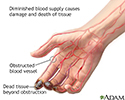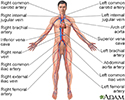Thromboangiitis obliterans
Buerger disease
Thromboangiitis obliterans is a rare disease in which blood vessels of the hands and feet become blocked.
Causes
Thromboangiitis obliterans (Buerger disease) is caused by small blood vessels that become inflamed and swollen. The blood vessels then narrow or get blocked by blood clots (thrombosis). Blood vessels of the hands and feet are mostly affected. Arteries are more affected than veins. Average age when symptoms begin is around 35. Women and older adults are affected less often.
This condition mostly affects young men ages 20 to 45 who are heavy smokers or chew tobacco. Female smokers in Western countries may also be affected. Many people with this problem have poor dental health, most likely due to tobacco use.
Symptoms
Symptoms most often affect 2 or more limbs and may include:
- Fingers or toes that appear pale, red, or bluish and feel cold to the touch.
- Sudden severe pain in the hands and feet. The pain may feel like a burning or tingling.
- Pain in the hands and feet that most often occurs when at rest. The pain may be worse when the hands and feet get cold or during emotional stress.
-
Pain in the legs
, ankles, or feet when walking (intermittent claudication). The pain is often located in the arch of the foot.
Pain in the legs
Leg pain is a common problem. It can be due to a cramp, injury, or other cause.
 ImageRead Article Now Book Mark Article
ImageRead Article Now Book Mark Article - Skin changes or small painful ulcers on the fingers or toes.
Exams and Tests
The following tests may show blockage of blood vessels in the affected hands or feet:
-
Ultrasound of the extremity, called
plethysmography
Plethysmography
Plethysmography is used to measure changes in volume in different parts of the body. The test may be done to check for blood clots in the arms and l...
 ImageRead Article Now Book Mark Article
ImageRead Article Now Book Mark Article -
Doppler ultrasound of the extremity
Doppler ultrasound of the extremity
This test uses ultrasound to look at the blood flow in the large arteries and veins in the arms and legs.
 ImageRead Article Now Book Mark Article
ImageRead Article Now Book Mark Article
Blood tests for other causes of inflamed blood vessels (vasculitis) and blocked (occlusion of) blood vessels may be done. These causes include diabetes , scleroderma , and atherosclerosis . There are no blood tests that diagnose thromboangiitis obliterans.
Diabetes
Diabetes is a chronic disease in which the body cannot regulate the amount of sugar in the blood.

Scleroderma
Scleroderma is a disease that involves the buildup of scar-like tissue in the skin and elsewhere in the body. It also damages the cells that line th...

Atherosclerosis
Hardening of the arteries, also called atherosclerosis, occurs when fat, cholesterol, and other substances build up in the walls of arteries. These ...

A heart echocardiogram may be done to look for sources of blood clots. In rare cases when the diagnosis is unclear, a biopsy of the blood vessel is done.
Biopsy
A biopsy is the removal of a small piece of tissue for laboratory examination.
Treatment
There is no cure for thromboangiitis obliterans. The goal of treatment is to control symptoms and prevent the disease from getting worse.
Stopping tobacco use of any kind is key to controlling the disease. Smoking cessation treatments are strongly recommended. It is also important to avoid cold temperatures and other conditions that reduce blood flow in the hands and feet.
Applying warmth and doing gentle exercises can help increase circulation.
Aspirin and medicines that open the blood vessels (vasodilators) may help. In very bad cases, surgery to cut the nerves to the area (surgical sympathectomy) can help control pain.
It may become necessary to amputate the fingers or toes if the area becomes very infected and tissue dies.
Outlook (Prognosis)
Symptoms of thromboangiitis obliterans may go away if the person stops tobacco use. People who continue to use tobacco may need repeated amputations.
Possible Complications
Complications include:
-
Tissue death (
gangrene
)
Gangrene
Gangrene is the death of tissue in part of the body.
 ImageRead Article Now Book Mark Article
ImageRead Article Now Book Mark Article - Amputation of fingers or toes
- Loss of blood flow in the limb of the affected fingers or toes
When to Contact a Medical Professional
Call your health care provider if:
- You have symptoms of thromboangiitis obliterans.
- You have thromboangiitis obliterans and symptoms get worse, even with treatment.
- You develop new symptoms.
Prevention
People with a history of Raynaud phenomenon or blue, painful fingers or toes, especially with ulcers, should not use any form of tobacco.
Raynaud phenomenon
Raynaud phenomenon is a condition in which cold temperatures or strong emotions cause blood vessel spasms. This blocks blood flow to the fingers, to...

References
Akar AR, Durdu S. Thromboangiitis obliterans. In: Cronenwett JL, Johnston KW, eds. Rutherford's Vascular Surgery . 8th ed. Philadelphia, PA: Elsevier Saunders; 2014:chap 79.
Stone JH. The systemic vasculitudes. In: Goldman L, Schafer AI, eds. Goldman's Cecil Medicine . 25th ed. Philadelphia, PA: Elsevier Saunders; 2016:chap 270.
-
Thromboangiites obliterans - illustration
Thromboangiitis obliterans is a disorder that leads to obstruction of the blood vessels of the hands and feet. The blood vessels become constricted or totally obstructed because of the inflammation and clots which reduces the availability of blood to the tissues. Thromboangiitis obliterans almost always affects men, 20 to 40 years old, who have a history of smoking or chewing tobacco.
Thromboangiites obliterans
illustration
-
Circulatory system - illustration
Blood used by the body is brought back to the heart and lungs by the veins of the body. Once the blood has gathered more oxygen from the lungs, it is pumped back out to the body through the arteries.
Circulatory system
illustration
-
Thromboangiites obliterans - illustration
Thromboangiitis obliterans is a disorder that leads to obstruction of the blood vessels of the hands and feet. The blood vessels become constricted or totally obstructed because of the inflammation and clots which reduces the availability of blood to the tissues. Thromboangiitis obliterans almost always affects men, 20 to 40 years old, who have a history of smoking or chewing tobacco.
Thromboangiites obliterans
illustration
-
Circulatory system - illustration
Blood used by the body is brought back to the heart and lungs by the veins of the body. Once the blood has gathered more oxygen from the lungs, it is pumped back out to the body through the arteries.
Circulatory system
illustration
Review Date: 7/21/2016
Reviewed By: Gordon A. Starkebaum, MD, Professor of Medicine, Division of Rheumatology, University of Washington School of Medicine, Seattle, WA. Also reviewed by David Zieve, MD, MHA, Isla Ogilvie, PhD, and the A.D.A.M. Editorial team.


